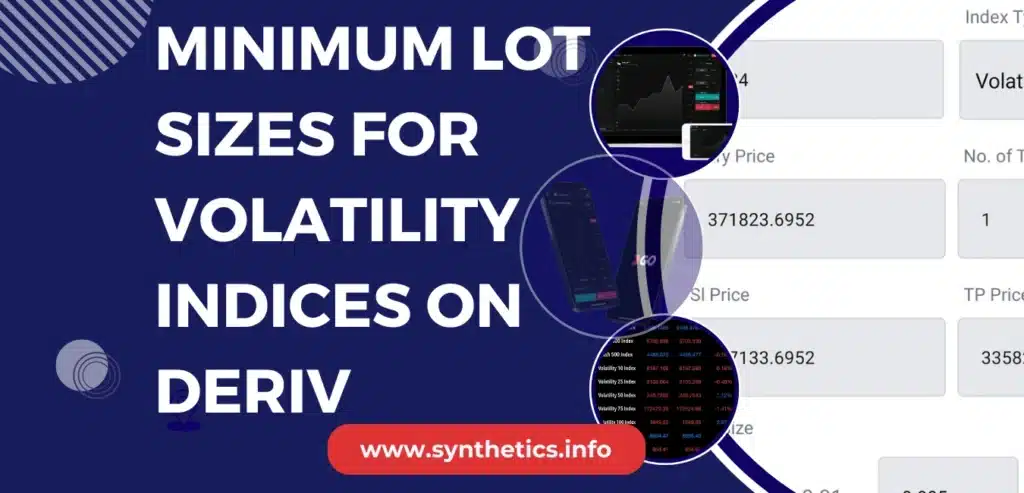When synthetic indices were introduced in 2016, I found myself getting confused about Volatility Indices lot size.
Coming from forex — where almost every pair had a minimum lot size of 0.01, and a 1 pip move was typically worth about 10 cents — I suddenly saw Volatility Indices minimum lot sizes that varied from 0.001 (Volatility 75) to 4 (Volatility 50)… and there was no clear correlation between point movement and USD value.
It was honestly confusing at first.
Now — almost ten years later — I still see new traders asking the same questions and running into the same confusion I had back then.
👉 That’s why I built this guide.
Here, I’ll show you exactly how much each point movement is worth in dollars — and the minimum lot size you can use on each Volatility Index.
This guide gives you real numbers you can trade with, not vague broker specs. You’ll see:
- The exact lot size you can start with on each index
- The dollar value per point movement
→ So you can manage risk properly and trade with confidence.
👉 If you’re serious about trading Volatility Indices — save this guide.
It will help you avoid accidental oversized trades or missing trades because your lot size was too small.
 Read Review
OPEN AN ACCOUNT
Read Review
OPEN AN ACCOUNT
Min Deposit: USD 1
Total Pairs: 100+
Regulators: MFSA, LFSA, VFSC, BVIFSC
What Are Volatility Indices?
Volatility Indices on Deriv are synthetic instruments designed to mimic market volatility — but without any underlying asset. They trade 24/7 on MT5 and are some of the most liquid and popular synthetic indices.
👉 Read more in our Volatility Indices Guide.
How Volatility Indices Lot Sizes Work: Points vs Pips
If you’re coming from forex, you’re used to working with pips and standard lot sizes (0.01 lots, 1 pip ≈ $0.10 on a micro lot, etc).
Volatility Indices work a little differently:
👉 MT5 uses a system of points — which is simply the smallest unit of price movement for an instrument.
👉 If you’re new to trading Volatility Indices on MT5, our MT5 trading guide shows you exactly how to set up the platform, add indicators, load Volatility Indices, and manage your trades.
👉 Each Volatility Index has:
- Its own minimum lot size
- Its own points system
- Its own dollar value per point movement
This is why you can’t assume 1 pip ≈ 1 cent anymore — the scaling varies hugely between indices.
👉 If you’re brand new to Synthetic Indices in general, you can also check our Synthetic Indices Overview for Beginners to get a full understanding of how these markets work.
How points working Volatility Indices:
- If the price has 2 digits after the decimal → 1 point = 0.01
→ Example: 500 points = 5.00
→ V10 (1s), V25 (1s), Jump Indices follow this style. - If the price has 4 digits after the decimal → 1 point = 0.0001
→ Example: 500 points = 0.05
→ Boom & Crash, some other synthetics use this format. - On Volatility Indices, it varies — and this is why I manually tested each one.
→ Some V Indices move in large points per dollar, others in small points.
👉 The key takeaway: Don’t blindly apply your Forex lot sizing logic here. Always check:
- Minimum lot size
- Dollar value per point
→ That’s exactly what the table below gives you.

Why Minimum Lot Size Matters
When you place a trade on a Volatility Index:
- You must use a lot size at or above the minimum allowed.
- You need to know the dollar value per point movement to size your stop loss and targets correctly.
If you size wrong — you risk blowing your account or being unable to enter trades.
Full Volatility Indices Lot Size & Dollar Value Table (2025)
Here’s the complete table I compiled after manually testing each Volatility Index on Deriv MT5:
| Volatility Index | Min Lot Size | Stop Level (Points) | Stop Level (USD) |
|---|---|---|---|
| Volatility 100 | 0.5 | 400 | $2 |
| Volatility 100 (1s) | 0.5 | 200 | $1 |
| Volatility 75 (1s) | 0.05 | 4000 | $2 |
| Volatility 50 (1s) | 0.005 | 40000 | $2 |
| Volatility 25 (1s) | 0.005 | 40000 | $2 |
| Volatility 10 (1s) | 0.5 | 400 | $2 |
| Volatility 250 (1s) | 0.5 | 1000 | $5 |
| Volatility 75 | 0.001 | 300000 | $3 |
| Volatility 50 | 4 | 10000 | $4 |
| Volatility 25 | 0.5 | 4000 | $2 |
| Volatility 10 | 0.5 | 4000 | $2 |
| Volatility 150 (1s) | 0.1 | 1000 | $1 |
| Volatility 30 (1s) | 0.2 | 10000 | $2 |
| Volatility 15 (1s) | 0.2 | 5000 | $1 |
| Volatility 90 (1s) | 0.2 | 50000 | $10 |
✅ All values tested live on Deriv MT5.
✅ $USD values reflect cost at Minimum Stop Level, for risk planning.
Comparing Volatility Indices by Lot Size
Some quick tips based on this data:
✅ Lowest starting lot size? → Volatility 75 → 0.001 lot
✅ Safest for small accounts? → The classic V 75 normal, V75 (1s), Volatility 15 (1s) & Volatility 150 (1s)
✅ Most expensive per point? → Volatility 90 (1s) → $10 at 50k points
✅ Great for scalping? → (1s) versions — lower stop levels and tighter $/point risk
If you’re starting with $10–50, I’d lean toward trading:
- V75 0.001 lot
- V75 (1s) 0.05 lot
- Volatility 15 (1s) 0.2 lot

How to Use This Volatility Indices Minimum Lot Size Guide (Tips for Beginners)
If you’re new to Volatility Indices:
- Always start with the lowest lot size allowed.
- Adjust your stop loss based on $USD risk, not points alone.
- (1s) Indices usually offer smoother moves and are easier to manage for small accounts.
- Volatility 75 (0.001 lot) is the most beginner-friendly starting point — tiny lot size, affordable risk.
👉 Pro tip → Don’t trade Vol 90 (1s), Vol 250 (1s), or big lot indices if you have a small account — they move fast and can wipe you out.
Volatility Indices Lot Sizes pdf Download 2025
👉 You can download the full Volatility Indices Lot Size PDF 2025 here:
👉 Prefer to preview the guide first? You can view the full Volatility Indices Lot Size PDF right here on the page before downloading.
🔗Related Guides
👉 Tips For Trading Volatility Indices
👉 Best Time to Trade Volatility Indices
👉 Advantages & Disadvantages For Trading Synthetic Indices
👉 Synthetic Indices Lot Size Guide (General)

Conclusion
Volatility Indices offer massive opportunity — but only if you understand how to size your trades safely.
Use this lot size guide to plan your trades, manage your risk, and avoid accidental oversized positions. I’ll keep this guide updated as Deriv updates their platforms.
👉 Have you noticed any changes in lot size or $/point value on your account? Share your tips below — let’s help each other stay updated!
FAQs On Volatility Indices Minimum Lot Size
0.001 lot — this is the smallest allowed on V75.
V75 and V75 (1s) give excellent control over $ risk per point.
Volatility 75 (0.001 lot) and V75 (1s) are the most flexible for small accounts.






💼 Recommended Brokers to Explore
Other Posts You May Be Interested In
Best Local Payment Methods for Funding & Withdrawing on Deriv (By Country 2025)
📅 Last updated: June 12, 2025 ✍️ Written by: Jafar Omar ✅ Fact-checked by: Taylor [...]
How To Open A Deriv Real Synthetic Indices Account in 2025 ☑️
📅 Last updated: June 12, 2025 ✍️ Written by: Jafar Omar ✅ Fact-checked by: Taylor [...]
Kiro: Free Binary Options Bot for Deriv Using Over 4 Strategy (2025)
📅 Last updated: June 22, 2025 ✍️ Written by: Jafar Omar ✅ Fact-checked by: Taylor [...]
Best Deriv Bot for Small Account: What Actually Works Without Blowing Your Balance
📅 Last updated: June 23, 2025 ✍️ Written by: Jafar Omar ✅ Fact-checked by: Taylor [...]
Deriv Wallet: How It Works, P2P Rules & Transfer Limits (2025)
📅 Last updated: July 15, 2025 ✍️ Written by: Jafar Omar ✅ Fact-checked by: Taylor [...]
Varus – Deriv Under 5 Bot with Safe PLS Recovery Strategy (2025)🤖
📅 Last updated: June 23, 2025 ✍️ Written by: Jafar Omar ✅ Fact-checked by: Taylor [...]